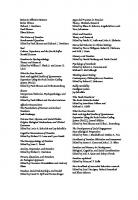Deep Listeners: Music, Emotion, and Trancing 0253343933, 0253216729, 2003021168
"A fascinating thesis and a timely synthesis. . . . Becker urges the reader to view certain arcane cultural rituals
312 88 19MB
English Pages 216 Year 2004
Title Page
Contents
Illustrations
Acknowledgements
Introduction
A Historical Interlude: Trance in Europe and the United States
1 Rethinking "Trance"
2 Deep Listeners
3 Habitus of Listening
4 Trancing Selves
5 Being-in-the-World: Culture and Biology
6 Magic through Emotion: Toward a Theory of Trance Conciousness
Postscript: Trancing, Deep Listening, and Human Evolution
Notes
Bibliography
Index
About the Author
Recommend Papers

- Author / Uploaded
- Judith Becker
File loading please wait...
Citation preview
JUDITH BECKER
Deep Listeners Music, Emotion, and Trancing INDIANA UNIVERSITY PRESS Bloomington and Indianapolis
This book is a publication of Indiana University Press 601 North Morton Street Bloomington, IN 47404-3797 USA http://iupress.indiana.edu
Telephone orders 800-842-(5796 Fax orders 812-855-7931 Orders by e-mail [email protected] © 2004 by Judith Becker
All rights reserved No part of this book may be reproduced or utilized in any form or by any means, electronic or mechanical, in cluding photocopying and recording, or by any information storage and retrieval system, without permission in , writing from the publisher. The Association of American University Presses Resolution on Permissions consti tutes the only exception to this prohibition. The paper used in this publication meets the minimum requirements of American National Standard for Infor mation Sciences-Permanence of Paper for Printed Library Materials, A NSI 239.48-1984. Manufactured in the United States of America Library of Congress Cataloging-in-Publication Data Becker, Judith 0. Deep listeners : music, emotion, and trancing / Judith Becker. p. cm. Includes bibliographical references (p. ) and index. ISBN 0-253-34393-3 (cloth: alk. paper) - ISBN 0-253-21672-9 (pbk.: alk. paper) 1. Music-Psychological aspects. 2. Music, Influence of. 3. Trance. 4. Emotions. I. Title. ML3838.B433 2004 781'.l 1-dc22 2003021168 I 2 3 4 5 09 08 07 06 05 04
Our normal waking consciousness, rational consciousness as we call it, is but one special type of consciousness, whilst all about it, parted from it by the filmiest of screens, there lie potential forms of consciousness entirely differ ent. We may go through life without suspecting their existence; but apply the requisite stimulus, and at a touch they are there in all their complete ness, definite types of mentality which probably somewhere have their field of application and adaptation. No account of the universe in its totality can be final which leaves these other forms of consciousness quite disregarded. How to regard them is the question,-for they are so discontinuous with or dinary consciousness. Yet they may determine attitudes though they cannot furnish formulas, and open a region though they fail to give a map. At any rate, they forbid a premature closing of our accounts with reality. -William James [ 1902] The Varieties ofReligious Experience
Contents List of Illustrations ix Acknowledgments x1 Introduction 1 Problems with Traditional Paradigms of Music Cognition 4 Languaging, Musicking, and Trancing 7 Multiple Senses of Embodiment 8 Chapter-by-Chapter Summary 10
A Historical Interlude: Trance in Europe and the United States 13 1. Rethinking «Trance" 25 Trancing and Culture 25 Trancing and Language 27 Universals of Trance Experience 29 Believability 30 Trancing and the Body 34 Defining Trance 38
2. Deep Listeners 45 Part One: Contemporary Deep Listeners Primary and Secondary Emotions 49 Musical Emotions 51 High Arousal 52 Deep Listeners and Transcendental Experience 54 Part Two: Ancient Deep Listeners, Rasa Theory Deep Listening, Trance, and the Srngara Rasa 60 Conclusion: Controlling the Uncontrollable 67
3. Habitus of Listening 69 Emotion as a Cultural Construct 71 Person and Emotion in the Habitus of Listening 73 Being a Griot 74 T he Habitus of Listening to the Sitar, Tambura, and Tabla 75 Music and Ecstasy: T he Sufis of the Nizamuddin Shrine, New Delhi 77 Music and Rage: Balinese Bebuten Trancing 82
4. Trancing Selves 87 T he Development of a Western "Self" 89 Possession Trance in Colonial Virginia 93 Possession Trance among Contemporary Pentecostals 97 Possession Trance in Sulawesi, Indonesia 100 Conclusion 105
5. Being-in-the-World: Culture and Biology 108 Part One: Rethinking Perception Edelman and the Theory of Neuronal Group Selection 112 Part Two: Biological Phenomenology Structural Coupling 119 Supra-individual Biological Processes 122 Rhythmic Entrainment 127 Conclusion 129
6. Magic through Emotion: Toward a T heory of Trance Consciousness 131 Introduction 131 Damasio's Theory of Two-Leveled Consciousness: "Core Consciousness" and "Extended Consciousness" 134 1. Core Consciousness 134 2. Extended Consciousness: The Autobiographical Self 139 Music and Core Consciousness: "Becoming the Music" 141 Music and Extended Consciousness in Trancing: The Loss of the Autobiographical Self 144 Trancing and Pain 147
Postscript: Trancing, Deep Listening, and Human Evolution 150 Notes 157 Bibliography 167 Index 187
vm Contents
Illustrations Plates (following page 82) Plate 1. Drawing of a yakka Plate 2.Meraj Ahmad Nizami and his troupe of qawwals Plate 3.Dancing Sufis Plate 4.Rangda Plate 5.Barong Plate 6. Bebuten trancers Plate 7.Balinese gamelan ensemble Plate 8.A bissu priest
Figures HI-1.Mesmer's salon 16 HI-2.Les Effets Du Magnetisme ...Animal 18 HI-3. Excerpt from score of Cosi Fan Tutte 19 HI-4. Charcot's classroom 21 1-1.Yak Tovil drummers Eralis, Sarath, and Jayaneti playing yak bera 31 1-2.Transcription of drumming to summon Kalu Yakka 33 2-1.A comparison of the common sense and James's theories of emotion 46 2-2.The brain stem 48 2-3.Location of brain stem 48 2-4.Primary emotions 50 2-5.Secondary emotions 50 2-6.Transcription of one verse of (( Shamas-ud-doha, badar-ud-doja" 64-66 3-1. Qawwals at Nizamuddin shrine, New Delhi, 1996 81 3-2.Rangda and bebuten trancers in the inner temple court after the Barong/Rangda ceremony 85 4-1.Evangelist meeting 95 4-2.






![Music--Motion and Emotion : The Developmental-Integrative Model of Music Therapy [1 ed.]
9781937440053, 9781937440091](https://ebin.pub/img/200x200/music-motion-and-emotion-the-developmental-integrative-model-of-music-therapy-1nbsped-9781937440053-9781937440091.jpg)


